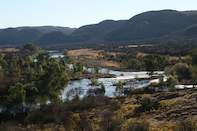Always Turbulent
Relations between the boers and the British were always turbulent. After the Great Trek, the British reluctantly acknowledged the independence of the boer republics, but they soon regretted the decision when it became clear that the South African interior might contain mineral wealth.

Diamonds were discovered in Kimberley in the 1860s and the first Anglo-Boer War broke out in 1880 (with the first shots being fired in Potchefstroom) and ended a year later in victory for the boers. In the last decade of the 1800s, however, the situation once again became untenable.
Following the discovery of gold in the Witwatersrand, the British began agitating for the two independent boer republics (the Zuid Afrikaanse Republiek and the Orange Free State) to be reincorporated into a federal South African state. The boers were having none of it and vowed to fight for their independence. The stand-off escalated until war became inevitable.
The Second Anglo-Boer War
The Second Anglo-Boer War (also called the South African War) was a long, drawn out affair. Finding themselves ill-equipped to fight the mighty British army, the boers turned this disadvantage into their favour by forming the men into small commandos.
These highly mobile commandoes would attack the British forces and then disappear into the bush. The British often gave chase but could not keep up with the elusive and dissipated boer force. The whole engagement soon deteriorated into a never-ending series of skirmishes and counter-attacks – the world’s first guerrilla war.
Finally, the British decided to play hard ball and initiated a ruthless scorched earth policy to starve out the resistance. Farms were burnt, and crops were destroyed. Women and children were arrested and transported to concentration camps, where starvation and disease were rife.
Master of the Dome
The Vredefort area was hard hit. By 1901, Lord Kitchener proudly reported that no supplies had been left in the Parys-Reitzburg region and several concentration camps were established in the area (including one that may have been used for black prisoners).
Eventually, the boers were forced to the negotiating table and a new dispensation for South Africa was drawn up. The conflict had raged from 1899 to 1902. For the purposes of our story, the mountain land of the Vredefort Dome proved to be the perfect playing field for the boer’s game of cat and mouse with the British.
The confusing series of parallel valleys and ridges offered abundant hiding places for the commandos, and the strategically important Vaal River cut right through the region. Master of the Dome was a remarkably resilient boer commander called Christiaan de Wet.
He was a constant thorn in the side of the British but managed to avoid capture time and again. He was such a slippery character that he earned the nickname ‘The Boer Pimpernel’.
A Popular Leader
Christiaan De Wet was a stern but popular leader. He first won fame at the Battle of Nicholson’s Nek, where a small boer force under his command defeated the British troops and captured 800 prisoners.
He was later promoted to commander in chief of the Free State commandos and took to his job with gusto. First, he disconcerted the British by attacking them from the rear. Then he blew up the railway bridge across the Vaal River and raided a British depot, seizing supplies worth half a million pounds. The British were getting angry.
So, in a major offensive, the British tried to capture the boer government which was then stationed in Bethlehem. De Wet and his commandos rode to the rescue but they couldn’t turn back the British. He did manage to get President Steyn and several important figures out of Bethlehem before it fell, however, and proceeded to escort them to Potchefstroom.
An Opportunity
Lord Kitchener now saw an opportunity to end the war once and for all, and sent out 50 000 troops to find Christiaan De Wet. This was the start of the First De Wet Hunt (there would eventually be three). Pursued by the British, De Wet and his convoy raced towards Vredefort, narrowly escaping the British cordon at every turn.
By now, the British had surrounded him in the east and the south, cutting off any access back into the Free State. De Wet would have to cross the Vaal. The question was where.
Lord Metheun, in charge of the British forces in the Transvaal, had been ordered to watch all the river crossings between Scandinavia Drift and Lindeques Drift, but there were at least 12 other fords between these two points and the British forces were already thinly stretched. De Wet grabbed his chance and took his people across the river at Schoemansdrift on 6 August 1900.
Dome Mountain Land
Metheun soon heard of the crossing and sent troops to cut off the boer advance into the Transvaal. Unfortunately, when they got to the area, they found a maze of concentric ridges and valleys that made pursuit very difficult. Christiaan De Wet, meanwhile, was zig-zagging through the Dome Mountain Land, heading for Potch.
He also sent out a small party to act as a decoy, and thus conned the British into thinking that he was going to return to the Free State via Lindeques Drift. While the British mobilised their troops in the wrong direction, De Wet snuck across the Mooi River and passed through Potch.
The British soon realised their mistake and renewed the pursuit, nipping at De Wet’s heels as they scarpered north towards the Magaliesberg. Running battles took place as the boers made a desperate dash for Olifants Nek, a pass on the western end of the Magaliesberg range.
Metheun believed that Olifants Nek was held by British forces and so sent his men to cover the other passes in the area. But he was wrong. The pass was open and De Wet raced across the mountains. The chase was over. The mouse had got away.
By David Fleminger